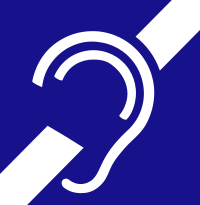
Photo from wikipedia
Recent advancements in neuroscientific research and miniaturized ear-electroencephalography (EEG) technologies have led to the idea of employing brain signals as additional input to hearing aid algorithms. The information acquired through… Click to show full abstract
Recent advancements in neuroscientific research and miniaturized ear-electroencephalography (EEG) technologies have led to the idea of employing brain signals as additional input to hearing aid algorithms. The information acquired through EEG could potentially be used to control the audio signal processing of the hearing aid or to monitor communication-related physiological factors. In previous work, we implemented a research platform to develop methods that utilize EEG in combination with a hearing device. The setup combines currently available mobile EEG hardware and the so-called Portable Hearing Laboratory (PHL), which can fully replicate a complete hearing aid. Audio and EEG data are synchronized using the Lab Streaming Layer (LSL) framework. In this study, we evaluated the setup in three scenarios focusing particularly on the alignment of audio and EEG data. In Scenario I, we measured the latency between software event markers and actual audio playback of the PHL. In Scenario II, we measured the latency between an analog input signal and the sampled data stream of the EEG system. In Scenario III, we measured the latency in the whole setup as it would be used in a real EEG experiment. The results of Scenario I showed a jitter (standard deviation of trial latencies) of below 0.1 ms. The jitter in Scenarios II and III was around 3 ms in both cases. The results suggest that the increased jitter compared to Scenario I can be attributed to the EEG system. Overall, the findings show that the measurement setup can time-accurately present acoustic stimuli while generating LSL data streams over multiple hours of playback. Further, the setup can capture the audio and EEG LSL streams with sufficient temporal accuracy to extract event-related potentials from EEG signals. We conclude that our setup is suitable for studying closed-loop EEG & audio applications for future hearing aids.
Journal Title: Frontiers in Neuroscience
Year Published: 2022
Link to full text (if available)
Share on Social Media: Sign Up to like & get
recommendations!